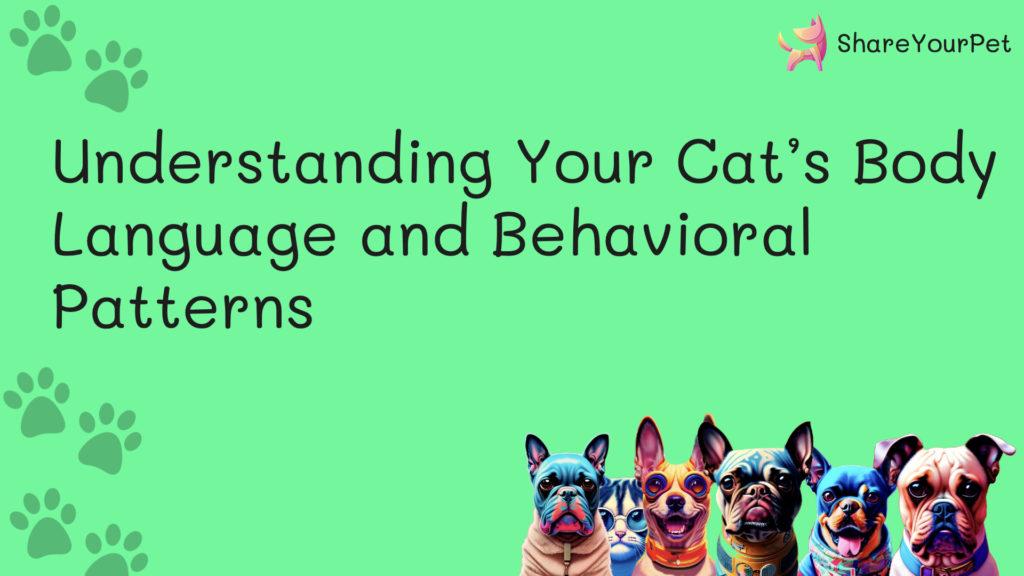Understanding Your Cat's Body Language and Behavioral Patterns
- Posted 2 years ago
- Behaviour
Introduction
Cats are fascinating creatures known for their enigmatic behavior and expressive body language. As cat owners, deciphering their gestures and actions can provide invaluable insights into their emotions and needs. By understanding your feline companion’s body language and behavioral patterns, you can strengthen your bond and provide the best care possible. In this article, we’ll explore the various aspects of cat communication and how you can interpret their cues effectively.
1. Tail Language
A cat’s tail is a crucial tool for communication. When held high with a slight curve at the tip, it signifies happiness and confidence. A flicking or swishing tail usually indicates excitement or arousal, while a puffed-up tail suggests fear or agitation. Conversely, a tucked tail signifies submission or discomfort. Pay close attention to your cat’s tail, as it can reveal much about their emotional state.
2. Ear Positions
Cats’ ears are remarkably expressive and can be an excellent indicator of their mood. When the ears are forward or slightly to the side, it shows curiosity and engagement. Flattened ears against the head may indicate fear or aggression. Understanding these ear positions can help you gauge your cat’s comfort level and decide whether to approach or give them space.
3. Eye Contact
Eye contact plays a significant role in feline communication. Staring directly into a cat’s eyes can be perceived as threatening, potentially leading to defensive behavior. Slow blinking, on the other hand, is a sign of trust and affection. If your cat blinks at you, try responding with a slow blink to show them that you feel the same way. This “cat kiss” can reinforce the bond between you and your furry friend.
4. Vocalizations
Cats are not as vocal as dogs, but they do communicate with a variety of sounds. A contented and friendly cat may purr softly, indicating their happiness and relaxation. Meowing is typically reserved for interactions with humans and can signal anything from hunger to a desire for attention. Hissing, growling, or yowling usually denote fear, anger, or discomfort. Understanding these vocalizations can help you respond appropriately to your cat’s needs.
5. Body Postures
A cat’s body posture can reveal a lot about its mood and intentions. Arched backs and upright fur suggest that the cat feels threatened or defensive. Conversely, a relaxed, stretched-out position indicates comfort and contentment. If your cat rolls onto its back, it may be a sign of trust, but be cautious, as it could also signal an invitation to play. Observing their body postures can help you gauge whether they are feeling at ease or uneasy in a given situation.
6. Grooming Behavior
Cats are meticulous groomers, and the act of grooming serves several purposes. Not only does it keep their coat clean, but it also serves as a self-soothing mechanism. If your cat is stressed or anxious, you may notice an increase in grooming behavior. However, excessive grooming can sometimes be a sign of an underlying health issue, so be attentive to any changes in grooming habits.
Conclusion
Understanding your cat’s body language and behavioral patterns is essential for fostering a strong and positive relationship with your feline companion. By paying attention to their tail language, ear positions, eye contact, vocalizations, body postures, and grooming behavior, you can gain valuable insights into their emotions and needs. This knowledge will help you provide the care and attention they require, ensuring that your cat leads a happy, healthy, and fulfilling life by your side. Remember, every cat is unique, so take the time to observe and learn your feline friend’s individual communication style and quirks. Happy bonding!
Visit our brand new meeting place at Share Your Pet: https://shareyourpet.org
Pet Sharing. Etsy for Pets. Get paid to care for pets.
Start your pet business on Share Your Pet.
Follow us on Twitter: https://twitter.com/shareyourpet01

